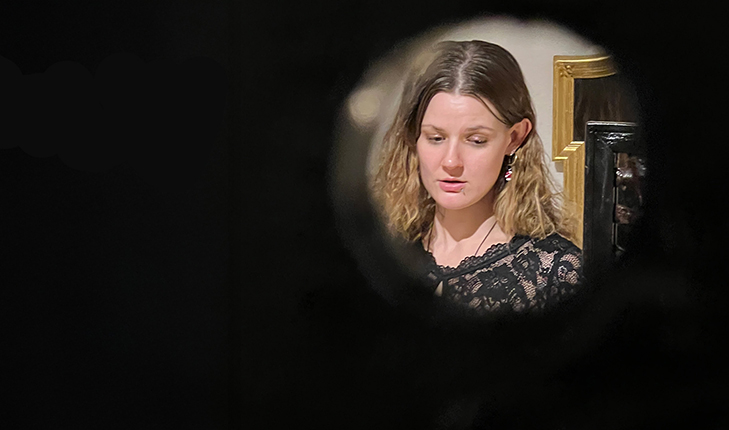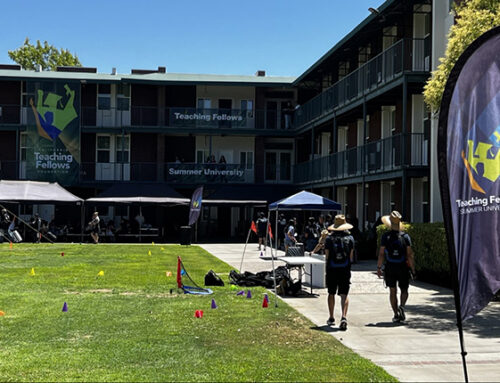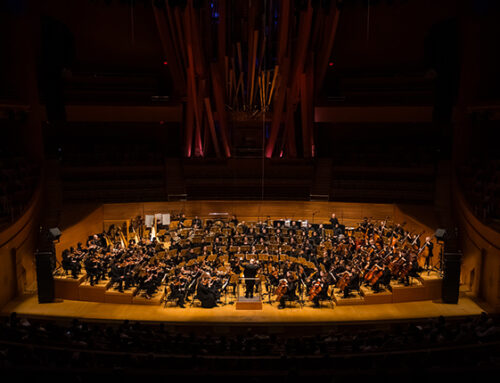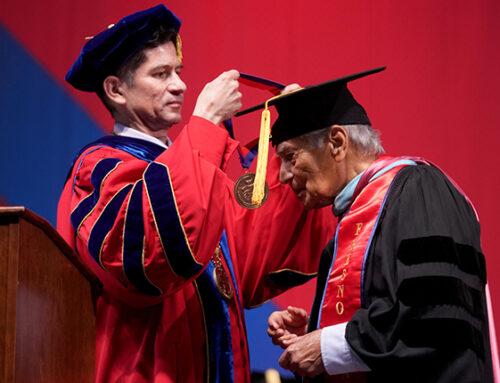It was a bitterly cold January morning in Copenhagen, Denmark. The day before had begun half a world away and was spent on airplanes, just to finally collapse in her hotel room, exhausted. But now, Sarah Theller, a Fresno State graduate student in art, excitedly moved through the brisk morning air towards the National Museum of Denmark to get there as soon as the doors opened.
The object she came to see in the grand halls and cavernous galleries was tiny.
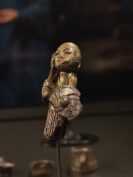 “It’s maybe the width of my pinky, but it’s a little bit shorter than my thumb. It’s very small,” Theller said. “It’s easy to miss because of how tiny it is. But I also knew what I was looking for, and I was able to just zero in.”
“It’s maybe the width of my pinky, but it’s a little bit shorter than my thumb. It’s very small,” Theller said. “It’s easy to miss because of how tiny it is. But I also knew what I was looking for, and I was able to just zero in.”
The tiny figurine from Late Iron Age Scandinavia is called the “Valkyrie from Hårby.” It was found in 2012 by an amateur archeologist. The piece was shaped in silver and gilded with a thin layer of gold.
Theller had previously traveled as a study abroad student, but this experience was different. Traveling alone allowed her to go beyond the group outings and lectures and explore her scholarship freely. With financial help from the Dean’s Council Annual Fund, funded in part by the community’s Day of Giving donations, she went to Copenhagen to study the tiny figurine as part of her thesis, “The Gilded Valkyrie: How Christianization and the Binary Concepts Distort Interpretation of Viking Iconography.”
While in Copenhagen, she met with Dr. Peter Pentz, an archaeologist and researcher with the National Museum of Denmark. While she could not personally meet with Dr. Leszek Dardela, senior researcher at the National Museum of Denmark, she did speak with him on Zoom. Both researchers are heavily cited in her thesis.
Growing up, Theller was obsessed with Norse mythology and stories of her ancestral Vikings, which she describes as a blend of myth, history and Christian Scandinavian tradition. She loved the ancient images, symbols and patterns of the Viking world.
While she was also fascinated by Greek and Roman art and mythological narratives, she began to notice that Viking art was not in the textbooks. She also observed that the Viking stories she had grown up with had striking parallels with stories in the Christian Bible.
“While researching Vikings’ history, beliefs and culture, it became evident that there are similarities between Christian and Norse tales because stories of the Vikings were not written by Viking Age Scandinavians themselves,” Theller said in her thesis. “Due to the inherent limitations of Christian-authored sources regarding pagan belief, and because we cannot just ask Vikings for clarification, we must use extant written sources with extreme caution and only in comparison with other surviving archaeological evidence.”
Theller posits that because the Vikings lacked a sophisticated written language, their history was written by outsiders who were inherently opposed to pagan beliefs and traditions. The gender norms of the Christian lens, she said, have also been applied to ancient Norse iconography. These representations can lead to perplexing results and possible confusion between myths and reality in the historical record.
“Because there was this Christian influence and this Christian conversion, I looked at how we conceptualized these peoples after Christianization – because Christianization is what left us a lot of the evidence we use to say what Vikings believed in,” Theller said.
As Theller researched Viking Age women and Valkyries, the Hårby figure kept popping up. With long hair tied in a knot, a dress and weapons, it seemed to be among the best cases of how a Christian gender lens could distort Viking history or possibly even confuse the reality of everyday life with myths.
“This is a unique figure, being so small yet three-dimensional and mega-detailed with sword, shield and detailed dress,” explained Theller. “It’s a very powerful figure, and it showcases very different gender socialization than we are used to, meaning we typically do not associate swords or weapons with women. They are typically thought of as ‘men’s objects.’”

Seeing the figurine and speaking with scholars in person brought Theller a deeper understanding of the subject beyond what she could surmise through online research. But beyond that academic experience, it allowed her to connect with her history at her ancestral land.
“It felt like being home. It just felt very comfortable. I felt safe. It felt familiar in a way. But at the same time, completely new.”
In addition to her thesis, Theller also presented “Ragnarök,” her graduate art exhibition at M Street, during the May 2023 ArtHop. The exhibition, she said, complemented her thesis as she explored the concept of Ragnarök or the twilight of the gods in Old Norse. The concept is similar to Armageddon, an end of all things. But as things end, it also marks the beginning of something new.
In May 2023, Theller graduated with a master’s degree in art. Theller’s thesis, chaired by Dr. Keith Jordan, received the 2023 College of Arts and Humanities Outstanding Thesis Award at her commencement ceremony.
 Fresno State’s annual 24-hour, online Day of Giving will be Wednesday, March 26. The College of Arts and Humanities relies on private financial support, such as funds raised from the Day of Giving, to support experiential learning activities for students. Visit fresnostate.dayofgiving.edu to learn how to support the College of Arts and Humanities today.
Fresno State’s annual 24-hour, online Day of Giving will be Wednesday, March 26. The College of Arts and Humanities relies on private financial support, such as funds raised from the Day of Giving, to support experiential learning activities for students. Visit fresnostate.dayofgiving.edu to learn how to support the College of Arts and Humanities today.

